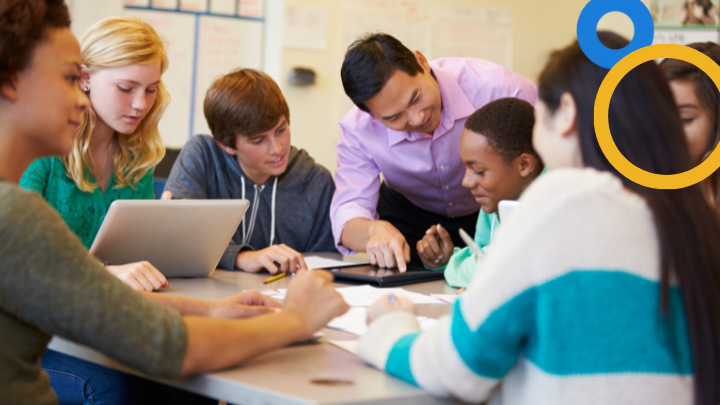An interview with Rabbi David Saltzman
As a former teacher and now as an instructional coach and the Senior Manager of Innovative Learning Experiences at BetterLesson, I continue to be fascinated by the idea of figuring out ways to give students more control over the pace of their instruction, while continuing to create the conditions for a meaningful collective learning experience.
This year, I have the privilege of working with Rabbi David Saltzman who is the Principal and Tefillah teacher at Maimonides Elementary School in Brookline, MA. David has been a teacher and an administrator for more than 20 years. You can read more about David here. He and I share the same passion for Self-Paced Learning — the idea of giving (almost) complete control of the pace of a learning progression to students, while supporting them to leverage their mistakes as learning opportunities via 1:1 or small group teaching. When David and I began our work together this year, we set a goal to use his Tefillah class as an incubator for self-paced experimentation. Halfway through the year, we reflected on what he has learned so far and what he can share with other educators interested in a similar quest. Our reflection is shared below.
Q&A
Romain Bertrand (RB): How would you summarize what you have been experimenting with in your classroom this year?
David Saltzman: I decided to transfer the content and assessments of my 5th grade Tefilla class (“prayer” in Hebrew) completely online. Students can access and learn the material in my Google Site, sharpen their reading skills and self-assess their progress at their own pace.
RB: What led you to want to do this?
DS: I am a firm believer in student-directed learning. The teacher should facilitate and guide student exploration and experience, but ultimately, students should have the ability to learn at their own pace, create their own products that demonstrate understanding, and decide how they want to work and with whom. Students should also be able to determine how well they think they know the content or have mastered a skill. Lifelong learning includes self-assessing and being able to determine when it’s time to start a new topic or challenge. When students feel in control of their learning in these areas, they will be more engaged, motivated and willing to learn and work.
I had taught a Tefilla class to 5th graders for seven years and I found that I was not reaching all students. Some students were mastering the content quickly while others were taking longer and not everyone was engaged at all times during direct instruction. Because of these hindrances, not everyone was able to deepen their understanding about Tefilla, develop their thinking skills in order to better appreciate prayer, or participate in class discussion. I was determined to create a Tefilla class where students would be engaged, be able to work collaboratively, and be excited to come to class. I also decided that I wanted a class where everyone would demonstrate mastery. In order to accomplish these goals, I moved the class to a self-paced structure, leveraging my Google Site.
RB: What impact has this shift had on your students?
DS: Students now look forward to class and they are excited about learning Tefilla. They are engaged almost 100% of the time and I am collecting much more data about what the students are learning and thinking. I believe this has helped further their knowledge about Tefilla and their appreciation of the prayer experience in a more profound way. They also learn how to use the Google suite of tools by using docs, forms, slides, and draw in order to answer questions and demonstrate and share their learning through electronic products.
Students also self-assess their own progress and knowledge. It gives them ownership of the learning and lets them feel that they are in control of their own pace class.
Here is what it looks like in my classroom on any given day:
Video of Students in Action:
I was also curious to hear from my students so I asked a colleague to interview a couple of them and gather their feedback.
Here is what they had to say:
RB: What strategies and resources would you like to share with other educators interested in a similar journey?
DS: The main platforms for me are Google sites and Google classroom. My students watch videos through Prezi, Googleslides, Animoto, Pow-Toon and other sites. They are assessed through Google forms, Quizlet and other online programs. The students work at their own pace on the Google sites and find the material mostly in Google classroom.
I also use Google forms, docs, slides, and draw for students to demonstrate their learning.
I used BetterLesson’s Progress and Mastery Tracking strategy to develop this student tracker. My students use it to track their progress, self-assess and record their actual assessment data. It is important to me that they do both: self-assess and demonstrate mastery.
Finally I have created and started testing with my students this “You Can Teach Tefilla!” Google doc. It is inspired by BetterLesson’s Mastery Map and Standards Based Peer Tutors strategy and its ultimate purpose is to encourage my students to volunteer their teaching or mentoring to support others once they have self-assessed at a level 4 (Ready to teach this concept to someone else).
RB: What are some changes you anticipate trying to make moving forward to improve upon your system?
DS: I would like to work with small groups more in order to discuss concepts at a deeper level with some and unscramble confusions with others. At the beginning of the process, I had to spend more time supporting them one-on-one to become comfortable with the different tech tools and a different form of learning. The idea behind the “You Can Teach Tefilla!” Google doc is to support my students in learning from each other more while I meet small groups. It is still taking time to hold at this point and I am curious to see where it goes.
RB: As a principal, what advice would you give teachers and leaders who would be interested in growing self-paced practices in their classrooms?
DS: I think for leaders the key resides in your willingness to create a culture of experimentation and innovation in your building. Ask yourself: “What could I do to make my teachers feel comfortable and safe to try innovative practices?”. We are working on fostering this culture right now at Maimonides Elementary School and we are starting to see the benefit of this shift. For example, a colleague has asked me to support him this Spring in building and testing a prototype of a similar system for his classroom.
For teachers, if the shift to a complete self-paced curriculum feels scary, do not hesitate to start small and test the idea on one lesson or one unit, maybe toward the end of the school year, so that you have time to reflect afterwards and determine if you would like to scale your idea up in 2019-2020. Start small, and gradually expand and improve.








